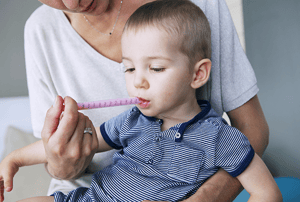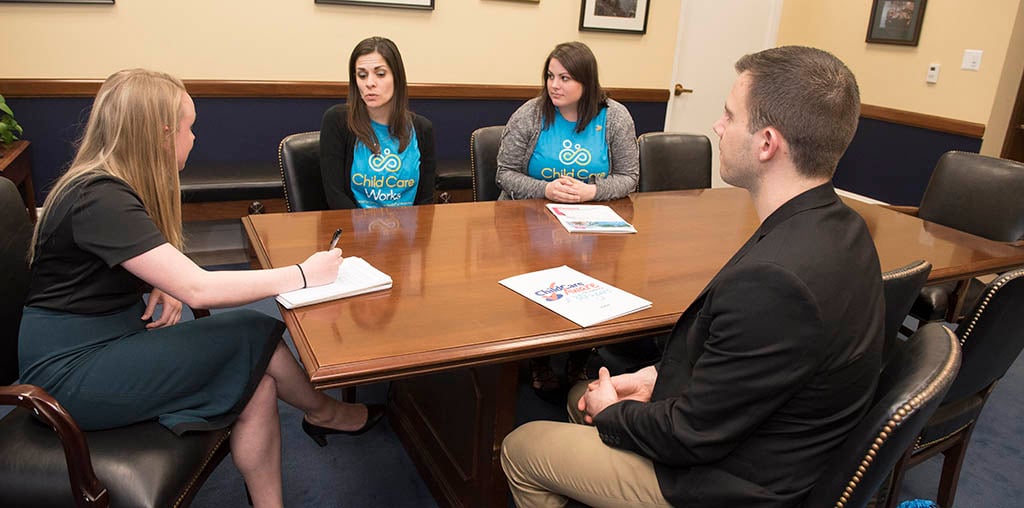 The use of medication for young children is on the rise. This increase is due to several reasons: the increase in asthma treatments, a greater reliance on medication for behavior control, and the increased incidence of some diseases. Most medications given to children are for colds, infections and pain or fever, but many children are diagnosed with chronic conditions such as Attention Deficit/Hyperactivity Disorder (ADHD), diabetes, depression or asthma where therapeutic drugs have become a way of life.
The use of medication for young children is on the rise. This increase is due to several reasons: the increase in asthma treatments, a greater reliance on medication for behavior control, and the increased incidence of some diseases. Most medications given to children are for colds, infections and pain or fever, but many children are diagnosed with chronic conditions such as Attention Deficit/Hyperactivity Disorder (ADHD), diabetes, depression or asthma where therapeutic drugs have become a way of life.
Educators and parents must work together to develop appropriate strategies for the use of medication in the child care or school setting. A child’s medical condition and the drugs being used to treat it require good communication between parents, teachers, nurses, providers, counselors, and children.
Keeping Records
By keeping good records of your child’s medical history, everything from immunizations to allergies, you will be prepared should she become seriously or chronically ill. Update your home health file regularly as you will need it again and again when enrolling your child in child care or summer programs. Take careful note of any medications that may have caused an adverse reaction.
Provide your child care provider or school nurse with the names and phone numbers of your child's health care professionals. For chronic conditions such as allergies, asthma, or diabetes, write down when the illness was first diagnosed, how it is being treated, and what drugs are being used for treatment. To help prevent a mix-up, be sure to write down any special instructions directly on the bottle, such as before or after meals, or with or without a drink. “Parents have a great deal of responsibility. Not only should they be knowledgeable about the drugs they give to their children at home, they need to consider how medication issues may affect others responsible for their children outside the home..." - Alan P. Agins, Ph.D.
Administering Medications in the Child Care or School Setting
Parents and school nurses or child care providers must develop a good system of communication with one another to know where medications are consistently kept, who has access to them and who administers them. Most questions about administering medications are best answered by the doctor or pharmacist but here are a few general guidelines you can keep in mind:
- Most liquids should be refrigerated as many can lose strength if stored at room temperature. Most antibiotics for young children can be taken with food but be aware of tetracycline which should not be taken with milk products and not used for children under age nine.
- Most asthma inhalers come with 200 puffs per vial. An inhaler that floats is a good sign that it's empty, but keeping track of the number of puffs used is most accurate.
- To measure medicine accurately, use a marked medication cup, dropper or spoon. An ordinary teaspoon is not accurate.
- Medication should be in the original, child-proof container. Parents can ask the pharmacy to divide the medications into two containers to avoid taking medication home from school each day.
- Be sure children take medications for as long as and exactly as prescribed. This is especially true with antibiotics.
Medication Permission Forms
For each medication a child is using, schools and child care centers must ask the parent to fill out and sign a form before the child is dropped off for care. Design your form with the following in mind:
- name, address and phone number of the child's doctor
- the name of the medication
- what the medication is for
- when to use the medication (when symptoms are displayed or at set times of day or for emergency)
- how to use the medication (pill, liquid, inhaler, full strength or diluted)
- special considerations (take with or without food/liquid or milk products)
- dosage or amount of medication
- how soon the medication should take effect
- how the medication should be stored
- possible side effects
- life expectancy of medication (expiration date or knowing when a container is empty, such as an asthma inhaler).
For medications taken on a long-term basis, schools and child care centers should know when to inform parents when medicines are low. A routine prescription refill can take as long as a week.
Wash It Down With Water
Recent research has shown that substances found in grapefruit juice can dramatically increase the potency of some medications. Other citrus juices can actually lessen the strength of certain drugs including some antibiotics.
It's a good idea to stick with water or a less acidic juice, such as apple, when giving medication. Stay away from milk too as it can cause adverse reactions with certain antibiotics. To be safe, ask your pediatrician or pharmacist about food and drug interactions before starting new prescriptions.
Side Effects
Parents and educators must be alert to any unusual symptoms as well as the impact of side effects on a child’s learning and behavior. Side effects can range from minimal to life threatening. So-called ‘minor’ side effects could be diarrhea, drowsiness or a rash. These are unpleasant but not intolerable.
Other side effects may warrant medical attention or at least a call to the doctor or health care provider. Symptoms to be aware of would include irregular heartbeat, protracted vomiting or diarrhea, fainting, extensive rash, seizures or convulsions, difficulty breathing, severe headaches, or yellowing of the skin or eyes. Be aware of the impact of medications and develop a critical awareness of what to look for.
For Your Reference
Parent & Educators’ Drug Reference: A Guide to Common Medical conditions and Medications for Children By Alan P. Agins, Ph.D., Pharmacologist Published by PRN Press, Cranston, RI, This easy-to-use medication guide provides practical information on how various drugs work, their side effects, and how medications impact children’s education. Explanations are given for common medical conditions and treatments for children. Throughout the book are helpful tips, recommendations, and suggestions for both parents and teachers.
Child Health Talk Newsletter for parents published by the National Black Child Development Institute. Visit www.nbcdi.org.
Healthy Child Care America Newsletter by the American Academy of Pediatrics for health care professionals, child care providers and families. Visit www.aap.org.
Childhood Depression: It is Real and It is Treatable
Depression is a serious health problem that affects people of all ages, including children and adolescents. Depression is the persistent experience of a sad or irritable mood and the loss of interest or pleasure in nearly all activities. These feelings are accompanied by a range of additional symptoms, affecting appetite and sleep, activity level and concentration, and feelings of self-worth.
Clinical depression is more than just "feeling blue" or having a bad day. And it's different from the feelings of grief or sorrow that might follow a major loss, such as a death in the family. It's not a personal weakness or a character flaw. Individuals suffering from clinical depression cannot simply "snap out of it."
Depression is a form of mental illness that affects the whole body - it impacts the way one feels, thinks, and acts. Depression in children can lead to school failure, alcohol or other drug use, and even suicide.
Know the Signs:
- Persistent sadness and hopelessness
- Withdrawal from friends and activities once enjoyed
- Increased irritability or agitation
- Changes in eating and sleeping habits (e.g. significant weight loss, or insomnia)
- Indecision, lack of concentration, or forgetfulness
- Feelings of worthlessness or excessive guilt
- Frequent physical complaints, such as headaches and stomachaches
- Lack of enthusiasm or motivation
- Low energy and chronic fatigue
- Recurring thoughts of death or suicide
Know the Facts:
- As many as one in every 33 children and one in eight adolescents may have depression. (U.S. Center for Mental Health Services (CMHS), 1996)
- Two-thirds of children with mental health problems do not get the help they need. (CMHS, 1996)
- A recent study led by Dr. Graham Emslie concluded that treatment of major depression is as effective for children as it is for adults. (American Medical Association, Archives of General Psychiatry, November 15, 1997)
What are some of the risk factors for depression?
- Children under stress, who have experienced loss, or who have attention, learning, or conduct disorders are at a higher risk for depression (American Academy of Child & Adolescent Psychiatry).
- Adolescent girls are more likely than adolescent boys to develop depression (National Institute of Mental Health).
- Adolescents and particularly children who develop depression are likely to have a family history of the disorder (National Institute of Mental Health).
- Four out of every five runaway youth suffer from depression (US Select Committee on Children, Youth & Families)
What are some of the consequences of depression?
- Once a young person has experienced an episode of depression, he or she is at risk for developing another depression within the next 5 years (Center for Mental Health Services).
- Depression in childhood may predict more severe depressive illness in adulthood (National Institute of Mental Health).
- Depression in children and adolescents is associated with an increased risk for suicidal behaviors (National Institute of Mental Health).
What can parents/adults do?
If parents or other adults in a young person's life suspect a problem with depression, they should:
- Be aware of the behaviors that concern them and note how long these behaviors have been going on, how often they occur, and how severe they seem.
- See a mental health professional or the child's doctor for evaluation and diagnosis.
- Get accurate information from libraries, hotlines, and other sources.
- Ask questions about treatments and services.
- Talk to other families in their community or find a family network organization.
It is important for people who have questions about, or are not satisfied with, the mental health care they are receiving to discuss their concerns with the provider, ask for more information, and seek help from other sources.
Help is Available
Depression is treatable. Early diagnosis and treatment are essential for children with depression. Children who exhibit symptoms of depression should be referred to, and further evaluated by, a mental health professional who specializes in treating depression in children and adolescents. The diagnostic evaluation may include psychological testing, laboratory tests, and consultation with other specialists. A comprehensive treatment plan may include psychotherapy, ongoing evaluation and monitoring, and in some cases, psychiatric medication. Optimally, this plan is developed with the family, and whenever possible, the child or adolescent is involved in the decisions.
The National Mental Health Association is a proud sponsor of Childhood Depression Awareness Day, also known as Green Ribbon Day because of the ribbons symbolizing children’s mental health. The goal of Green Ribbon Day is to increase public awareness of childhood depression through a nationwide social marketing strategy, to help reduce the stigma and misinformation surrounding childhood depression, and to increase awareness of warning signs and treatment resources. Join us on May 09, 2000, Green Ribbon Day, and help bring the public’s attention to this very important subject. Established in 1909, the National Mental Health Association works to promote mental health, prevent mental disorders, and achieve victory over mental illnesses.
The Daily Parent is prepared by NACCRRA, the National Association of Child Care Resource and Referral Agencies.
© 2012 NACCRRA. All rights reserved.





